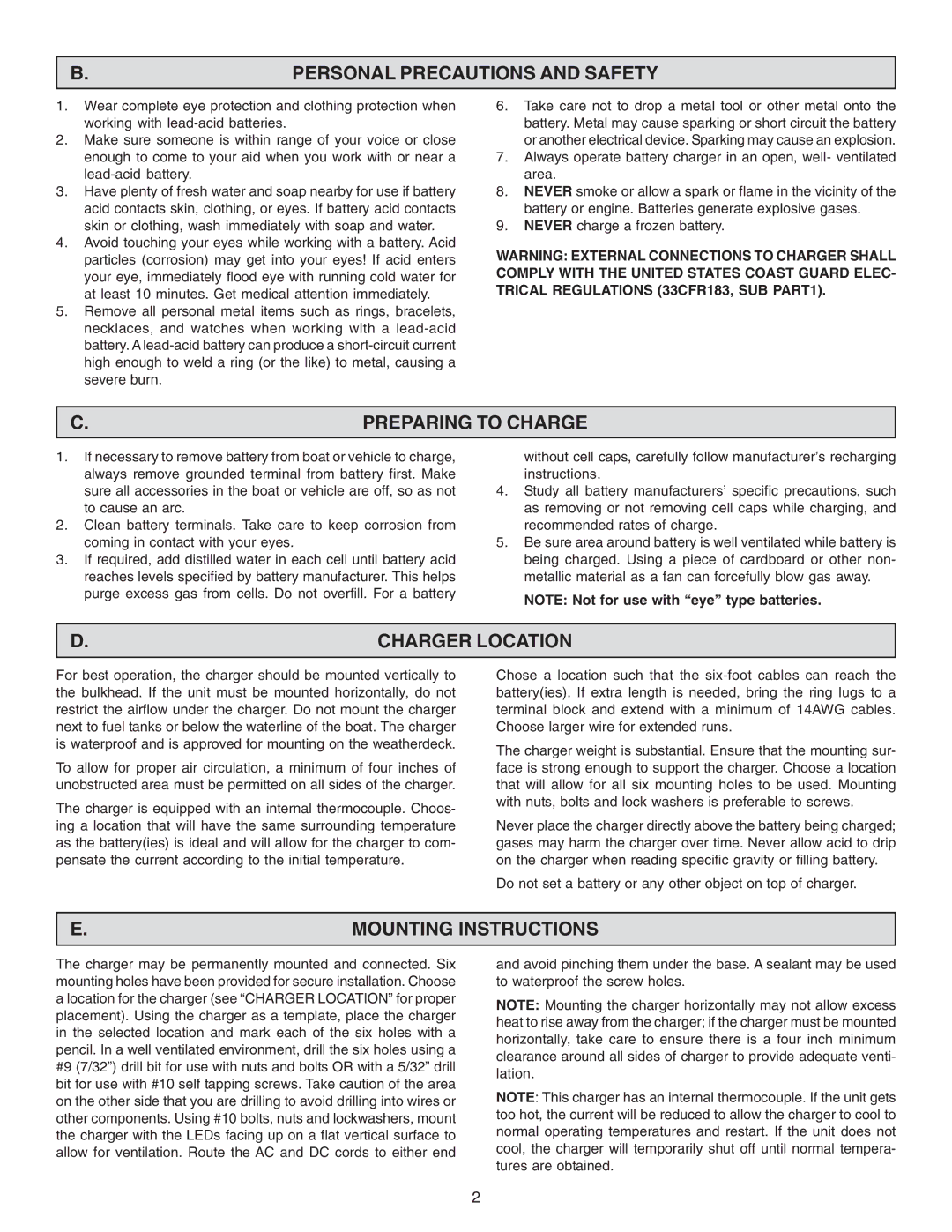
B. | PERSONAL PRECAUTIONS AND SAFETY |
1.Wear complete eye protection and clothing protection when working with
2.Make sure someone is within range of your voice or close enough to come to your aid when you work with or near a
3.Have plenty of fresh water and soap nearby for use if battery acid contacts skin, clothing, or eyes. If battery acid contacts skin or clothing, wash immediately with soap and water.
4.Avoid touching your eyes while working with a battery. Acid particles (corrosion) may get into your eyes! If acid enters your eye, immediately flood eye with running cold water for at least 10 minutes. Get medical attention immediately.
5.Remove all personal metal items such as rings, bracelets, necklaces, and watches when working with a
6.Take care not to drop a metal tool or other metal onto the battery. Metal may cause sparking or short circuit the battery or another electrical device. Sparking may cause an explosion.
7.Always operate battery charger in an open, well- ventilated area.
8.NEVER smoke or allow a spark or flame in the vicinity of the battery or engine. Batteries generate explosive gases.
9.NEVER charge a frozen battery.
WARNING: EXTERNAL CONNECTIONS TO CHARGER SHALL COMPLY WITH THE UNITED STATES COAST GUARD ELEC- TRICAL REGULATIONS (33CFR183, SUB PART1).
C. | PREPARING TO CHARGE |
1.If necessary to remove battery from boat or vehicle to charge, always remove grounded terminal from battery first. Make sure all accessories in the boat or vehicle are off, so as not to cause an arc.
2.Clean battery terminals. Take care to keep corrosion from coming in contact with your eyes.
3.If required, add distilled water in each cell until battery acid reaches levels specified by battery manufacturer. This helps purge excess gas from cells. Do not overfill. For a battery
without cell caps, carefully follow manufacturer’s recharging instructions.
4.Study all battery manufacturers’ specific precautions, such as removing or not removing cell caps while charging, and recommended rates of charge.
5.Be sure area around battery is well ventilated while battery is being charged. Using a piece of cardboard or other non- metallic material as a fan can forcefully blow gas away.
NOTE: Not for use with “eye” type batteries.
D. | CHARGER LOCATION |
For best operation, the charger should be mounted vertically to the bulkhead. If the unit must be mounted horizontally, do not restrict the airflow under the charger. Do not mount the charger next to fuel tanks or below the waterline of the boat. The charger is waterproof and is approved for mounting on the weatherdeck.
To allow for proper air circulation, a minimum of four inches of unobstructed area must be permitted on all sides of the charger.
The charger is equipped with an internal thermocouple. Choos- ing a location that will have the same surrounding temperature as the battery(ies) is ideal and will allow for the charger to com- pensate the current according to the initial temperature.
Chose a location such that the
The charger weight is substantial. Ensure that the mounting sur- face is strong enough to support the charger. Choose a location that will allow for all six mounting holes to be used. Mounting with nuts, bolts and lock washers is preferable to screws.
Never place the charger directly above the battery being charged; gases may harm the charger over time. Never allow acid to drip on the charger when reading specific gravity or filling battery.
Do not set a battery or any other object on top of charger.
E. | MOUNTING INSTRUCTIONS |
The charger may be permanently mounted and connected. Six mounting holes have been provided for secure installation. Choose a location for the charger (see “CHARGER LOCATION” for proper placement). Using the charger as a template, place the charger in the selected location and mark each of the six holes with a pencil. In a well ventilated environment, drill the six holes using a #9 (7/32”) drill bit for use with nuts and bolts OR with a 5/32” drill bit for use with #10 self tapping screws. Take caution of the area on the other side that you are drilling to avoid drilling into wires or other components. Using #10 bolts, nuts and lockwashers, mount the charger with the LEDs facing up on a flat vertical surface to allow for ventilation. Route the AC and DC cords to either end
and avoid pinching them under the base. A sealant may be used to waterproof the screw holes.
NOTE: Mounting the charger horizontally may not allow excess heat to rise away from the charger; if the charger must be mounted horizontally, take care to ensure there is a four inch minimum clearance around all sides of charger to provide adequate venti- lation.
NOTE: This charger has an internal thermocouple. If the unit gets too hot, the current will be reduced to allow the charger to cool to normal operating temperatures and restart. If the unit does not cool, the charger will temporarily shut off until normal tempera- tures are obtained.
2
